Can filing a patent application be a SMART goal?
![]()
Yes, it can. Filing a patent application is a Specific action that is Measurable; you get a formal filing receipt indicating that your application fulfilled all the filing requirements and is now pending. If you are committed to working with your patent counsel, filing a patent application is Achievable. If you are trying to protect an invention that you intend to become commercialized, filing a patent application is Relevant, and if you commit to an absolute deadline on when the filing should occur, then it is Timely.
But can your patent application be SMART? YES!!!
SPECIFIC
A patent application is comprised of several parts. The Background, Summary of the Invention, the Short Description of the Figures, and the Detailed Description collectively make up the Specification, while the Claims and Abstract round out the patent application.
In the Specification, we describe the invention — from the broadest terms possible that achieves the intended utility/function — to the more specific elements/limitations that optimize the invention. You should describe all conceivable embodiments; from the most basic embodiments to the preferred embodiments. Embodiments are essentially different versions of your invention.
To increase understanding of your invention, you should show your embodiments with all the necessary elements/parts in the Figures. For physical items-show differing views — front view, top view, side view, bi-sectional view to see the inside of the device, exploded views to see the various parts; close-up views of intricate configurations, etc. Use flow charts to enhance the understanding of methods or processes.
The Figures should be described in excruciating detail; you must describe every configuration and every element that comprises the configurations and how they cooperate to achieve a purpose or utility; all elements and configurations must be labeled with a numeral in the figures, and every device/part/subpart that is labeled in the Figures with a numeral must be described.
MEASURABLE
The Claims are the most important part of an application because legally, they actually define the invention. Interpretation of the claims is what determines whether an invention is novel and not obvious as measured against prior art. Prior art is anything before your filing date that discloses the matter related to your invention, generally other patents, applications, and other publications. But other products,
promotional materials, videos, websites, etc. can be cited against you.
What does it mean to be novel? It is easier to describe it in terms of what is not novel: To not be novel, every claim element or its functional equivalent must be contained in one prior art document cited against the claim. The art cited does not have to be in same the field as the invention.
Even if you have something that is completely unique and novel, your invention still might not be patentable because it is considered obvious. Claims must not be obvious to a Person Having Ordinary Skill In The Art (PHOSITA-basically the average person in the field). Generally, the examiner argues that two documents (or more) could be combined by a PHOSITA to come up with your invention. Though in real life, nobody comes up with an idea that way!! Obviousness can also be shown by the general knowledge in the field, “common sense” or predictability of results. Obviousness is the basis of most examiner rejections; it is the hardest to overcome because it is a more subjective opinion than novelty, and it is the hardest concept to explain to a client about why their claim is being rejected.
Claims come in two forms – Independent Claims and Dependent Claims. Independent Claims disclose the invention using the broadest definitions and using the least amount of limitations. Essentially you are trying to define only what is minimally necessary for a functional invention; what is adequate, not what is optimal (no bells and whistles). We tend to use generic descriptions as opposed to specifically defined features/elements or try to use functional language in defining the invention as opposed to defining the invention with structure. Independent claims measure and test the broad boundaries of the invention in comparison to the prior art.
Dependent Claims further refine your invention with claims of more narrow scope and are used as fallback positions if the independent claims are rejected or invalidated. Often additional limitations are in the Dependent Claims to further distinguish the invention from prior art by more specifically defining features/elements. Dependent Claims also disclose additional features or elements that enhance or optimize your invention, or are used to define alternatives. The narrowest type of Dependent Claim is termed a “picture claim”. Basically, this claim discloses a very specific and definite embodiment; usually, the exact product to be sold.
ACHIEVABLE
Two other requirements a patent application must satisfy are the Written Description and the Enablement requirements. The Written Description requirement implements the principle that a patent must describe the technology that is sought to be patented; the requirement serves both to satisfy the inventor’s obligation to disclose the technological knowledge upon which the patent is based, and to demonstrate that the patentee was in possession of the invention that is claimed.
For the Enablement requirement, the application must contain sufficient information regarding the subject matter of the claims to enable one skilled in the pertinent art to make and use the claimed invention without undue experimentation. These requirements are distinct. An invention may be described without the disclosure being enabling (e.g., a chemical compound for which there is no disclosed or apparent method of making), and a disclosure could be enabling without describing the invention (e.g., a specification describing a method of making and using a paint composition made of functionally defined ingredients within broad ranges would be enabling for formulations falling
within the description but would not describe any specific formulation).
RELEVANT
The last requirement the patent application must satisfy is the Utility requirement. People invent things to solve problems, so the Utility requirement (usefulness) is usually self-evident; you simply must be able to claim some benefit arising from the invention. In the Background of a patent application, we describe the field and what problem is being solved. We then go on to elaborate on how previously the problem was solved, or even if it was recognized as a problem until now. We describe the deficiencies of previous technologies. Whether they truly solved the problem, or even if they solved the problem, they did so inadequately and improvements are needed. Maybe a previous technology solved the problem adequately, but not optimally, and advantages were unrealized until your invention.
TIMELY
Generally speaking, the earlier you file a patent application that discloses your invention, the better off you will be. Less prior art can be cited against you. In the U.S., under the America Invents Act (the current patent law) we are now a First (inventor)-to-File country. This change brings the U.S. system more closely in line with the majority of the world and is a significant departure from the old First-to-Invent system.
The current law provides that a person shall be entitled to a patent unless the claimed invention was publicly disclosed prior to the effective filing date of the patent application (i.e. prior art). Meaning that if your invention is known in any way, shape, or form to the public, your invention is not patentable. This knowledge could from an actual product in the market, science or tradeshow literature, or other patents or
patent applications.
Exceptions remain in the current U.S. patent law for public disclosures made by the inventor or by another who received the information from the inventor one year or less (grace period) before the effective filing date of the patent application. However, you need to remember unlike the U.S., many foreign countries require absolute novelty and have no grace period, meaning that any public disclosure
you make would be considered prior art in those countries and would ultimately prevent you from receiving an issued patent.
Pittsburgh Intellectual Property Attorneys
Kathleen Kuznicki assists business owners, entrepreneurs, and inventors with all things related to intellectual property and brand protection, including patents, trademarks, copyrights, and licensing. She can be reached via email at kkuznicki@lynchlaw-group.com or by calling our office at 724-776-8000.




